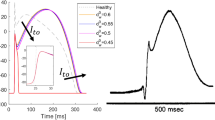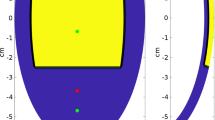Abstract
During acute myocardial ischemia, reentrant episodes may lead to ventricular fibrillation (VF), giving rise to potentially mortal arrhythmias. VF has been traditionally related to dispersion of refractoriness and more recently to the source–sink relationship. Our goal is to theoretically investigate the relative role of dispersion of refractoriness and source–sink mismatch in vulnerability to reentry in the specific situation of regional myocardial acute ischemia. The electrical activity of a regionally ischemic tissue was simulated using a modified version of the Luo-Rudy dynamic model. Ischemic conditions were varied to simulate the time-course of acute ischemia. Our results showed that dispersion of refractoriness increased with the severity of ischemia. However, no correlation between dispersion of refractoriness and the width of the vulnerable window was found. Additionally, in approximately 50% of the reentries, unidirectional block (UDB) took place in cells completely recovered from refractoriness. We examined patterns of activation after premature stimulation and they were intimately related to the source–sink relationship, quantified by the safety factor (SF). Moreover, the isoline where the SF dropped below unity matched the area where propagation failed. It was concluded that the mismatch of the source–sink relationship, rather than solely refractoriness, was the ultimate cause of the UDB leading to reentry. The SF represents a very powerful tool to study the mechanisms responsible for reentry.






Similar content being viewed by others
References
Allessie, M.A., F.I. Bonke, F.J. Schopman. 1976. Circus movement in rabbit atrial muscle as a mechanism of tachycardia. II. The role of nonuniform recovery of excitability in the occurrence of unidirectional block, as studied with multiple microelectrodes. Circ. Res. 39:168-177.
Allessie, M.A., F.I. Bonke, and F.J. Schopman. 1977. Circus movement in rabbit atrial muscle as a mechanism of tachycardia. III. The “leading circle” concept: a new model of circus movement in cardiac tissue without the involvement of an anatomical obstacle. Circ. Res. 41:9-18.
Azene, E.M., N.A. Trayanova, E. Warman. 2001. Wave front-obstacle interactions in cardiac tissue: a computational study. Ann. Biomed. Eng. 29:35-46. doi:10.1114/1.1332083
Cascio, W.E. 2001. Myocardial ischemia: what factors determine arrhythmogenesis? J. Cardiovasc. Electrophysiol. 12:726-729. doi:10.1046/j.1540-8167.2001.00726.x
Chen, P.S., P.D. Wolf, E.G. Dixon, N.D. Danieley, D.W. Frazier, W.M. Smith, and R.E. Ideker. 1988. Mechanism of ventricular vulnerability to single premature stimuli in open-chest dogs. Circ. Res. 62:1191-1209.
Clayton, R.H., A.V. Holden. 2005. Dispersion of cardiac action potential duration and the initiation of re-entry: a computational study. Biomed. Eng. Online. 4:11. doi:10.1186/1475-925X-4-11
Coronel, R. 1994. Heterogeneity in extracellular potassium concentration during early myocardial ischaemia and reperfusion: implications for arrhythmogenesis. Cardiovasc. Res. 28:770-777. doi:10.1093/cvr/28.6.770
Coronel, R., J.W. Fiolet, F.J. Wilms-Schopman, A.F. Schaapherder, T.A. Johnson, L.S. Gettes, M.J. Janse. 1988. Distribution of extracellular potassium and its relation to electrophysiologic changes during acute myocardial ischemia in the isolated perfused porcine heart. Circulation 77:1125-1138.
Coronel, R., F.J. Wilms-Schopman, L.R. Dekker, M.J. Janse. 1995. Heterogeneities in [K +]o and TQ potential and the inducibility of ventricular fibrillation during acute regional ischemia in the isolated perfused porcine heart. Circulation 92:120-129.
Danse, P.W., C.J. Garratt, F. Mast, M.A. Allessie. 2000. Preferential depression of conduction around a pivot point in rabbit ventricular myocardium by potassium and flecainide. J. Cardiovasc. Electrophysiol. 11:262-273. doi:10.1111/j.1540-8167.2000.tb01795.x
Delgado, C., B. Steinhaus, M. Delmar, D.R. Chialvo, J. Jalife. 1990. Directional differences in excitability and margin of safety for propagation in sheep ventricular epicardial muscle. Circ. Res. 67:97-110.
Downar, E., M.J. Janse, D. Durrer. 1977. The effect of “ischemic” blood on transmembrane potentials of normal porcine ventricular myocardium. Circulation 55:455-462.
Faber, G.M., and Y. Rudy. 2000. Action potential and contractility changes in [Na(+)](i) overloaded cardiac myocytes: a simulation study. Biophys. J. 78:2392-2404. doi:10.1016/S0006-3495(00)76783-X
Fei, H., D. Yazmajian, M.S. Hanna, and L.H. Frame. 1997. Termination of reentry by lidocaine in the tricuspid ring in vitro. Role of cycle-length oscillation, fast use-dependent kinetics, and fixed block. Circ. Res. 80:242-252.
Ferrero, J.M., Jr., J. Saiz, J.M. Ferrero, and N.V. Thakor. 1996. Simulation of action potentials from metabolically impaired cardiac myocytes. Role of ATP-sensitive K + current. Circ. Res. 79:208-221.
Ferrero, J.M., Jr., J. Saiz, J.M. Ferrero, Sr., and N.V. Thakor. 1999. Postrepolarization refractoriness in ventricular cardiac cells: a simulation study. Computers in Cardiology 26:487-490.
Ferrero, J.M., B. Trenor, B. Rodriguez, and J. Saiz. 2003. Electrical activity and reentry during acute myocardial ischemia: insights from simulations. Intl. J. Bifurcat. Chaos 13:67-78. doi:10.1142/S0218127403008806
Franz, M.R. 2003. The electrical restitution curve revisited: steep or flat slope-which is better? J. Cardiovasc. Electrophysiol. 14:S140-S147. doi:10.1046/j.1540.8167.90303.x
Gough, W.B., R. Mehra, M. Restivo, R.H. Zeiler, N. el Sherif. 1985. Reentrant ventricular arrhythmias in the late myocardial infarction period in the dog. 13. Correlation of activation and refractory maps. Circ. Res. 57:432-442.
Han, J., and G.K. Moe. 1964. Nonuniform recovery of excitability in ventricular muscle. Circ. Res. 14:44-60.
Irisawa, H., and R. Sato. 1986. Intra- and extracellular actions of proton on the calcium current of isolated guinea pig ventricular cells. Circ. Res. 59:348-355.
Jalife, J. 2000. Ventricular fibrillation: mechanisms of initiation and maintenance. Annu. Rev. Physiol. 62:25-50. doi:10.1146/annurev.physiol.62.1.25
Janse, M.J., and A.G. Kleber. 1981. Electrophysiological changes and ventricular arrhythmias in the early phase of regional myocardial ischemia. Circ. Res. 49:1069-1081.
Kagiyama, Y., J.L. Hill, and L.S. Gettes. 1982. Interaction of acidosis and increased extracellular potassium on action potential characteristics and conduction in guinea pig ventricular muscle. Circ. Res. 51:614-623.
Keener, J.P. 1988. On the formation of circulating patterns of excitation in anisotropic excitable media. J. Math. Biol. 26:41-56.
Kleber, A.G., and Y. Rudy. 2004. Basic mechanisms of cardiac impulse propagation and associated arrhythmias. Physiol. Rev. 84:431-488. doi:10.1152/physrev.00025.2003
Kucera, J.P., and Y. Rudy. 2001. Mechanistic insights into very slow conduction in branching cardiac tissue: a model study. Circ. Res. 89:799-806. doi:10.1161/hh2101.098442
Kuo, C.-S., C.P. Reddy, K. Munakata, and B. Surawicz. 1985. Arrhythmias dependent predominantly on dispersion of repolarization. Cardiac Electrophysiology and Arrhythmias. 277-285.
Laurita, K.R., and D.S. Rosenbaum. 2000. Interdependence of modulated dispersion and tissue structure in the mechanism of unidirectional block. Circ. Res. 87:922-928.
Leon, L.J., and F.A. Roberge. 1991. Directional characteristics of action potential propagation in cardiac muscle. A model study. Circ. Res. 69:378-395.
Luo, C.H., and Y. Rudy. 1991. A model of the ventricular cardiac action potential. Depolarization, repolarization, and their interaction. Circ. Res. 68:1501-1526.
Naimi, S., B. Avitall, J. Mieszala, and H.J. Levine. 1977. Dispersion of effective refractory period during abrupt reperfusion of ischemic myocardium in dogs. Am. J. Cardiol. 39:407-412. doi:10.1016/S0002-9149(77)80097-0
Ogawa, S., I. Furuno, Y. Satoh, S. Yoh, K. Saeki, T. Sadanaga, H. Katoh, and Y. Nakamura. 1991. Quantitative indices of dispersion of refractoriness for identification of propensity to re-entrant ventricular tachycardia in a canine model of myocardial infarction. Cardiovasc. Res. 25:378-383. doi:10.1093/cvr/25.5.378
Ong, J.J., Y.M. Cha, J.M. Kriett, K. Boyce, G.K. Feld, and P.S. Chen. 1995. The relation between atrial fibrillation wavefront characteristics and accessory pathway conduction. J. Clin. Invest. 96:2284-2296. doi:10.1172/JCI118284
Padrini, R., S. Bova, G. Cargnelli, D. Piovan, and M. Ferrari. 1992. Effects of pinacidil on guinea-pig isolated perfused heart with particular reference to the proarrhythmic effect. Br. J. Pharmacol. 105:715-719.
Qu, Z., H.S. Karagueuzian, A. Garfinkel, and J.N. Weiss. 2004. Effects of Na(+) channel and cell coupling abnormalities on vulnerability to reentry: a simulation study. Am. J. Physiol. Heart Circ. Physiol. 286:H1310-H1321. doi:10.1152/ajpheart.00561.2003
Rodriguez, B., J.M. Ferrero, and B. Trenor. 2002. Mechanistic investigation of extracellular K + accumulation during acute myocardial ischemia: a simulation study. Am. J. Physiol. Heart Circ. Physiol. 283:H490-H500.
Romero, L., B. Trenor, J. M Ferrero, Jr., and J. Saiz. 2005. A sensitivity study of the safety factor for conduction in the myocardium. Comput. Cardiol. 32:873-876. doi:10.1109/CIC.2005.1588244
Shaw, R.M., and Y. Rudy. 1997. Electrophysiologic effects of acute myocardial ischemia. A mechanistic investigation of action potential conduction and conduction failure. Circ. Res. 80:124-138.
Shaw, R.M., and Y. Rudy. 1997. Ionic mechanisms of propagation in cardiac tissue. Roles of the sodium and L-type calcium currents during reduced excitability and decreased gap junction coupling. Circ. Res. 81:727-741.
Trenor, B., J.M. Ferrero, B. Rodriguez, and F. Montilla. 2005. Effects of pinacidil on reentrant arrhythmias generated during acute regional ischemia: A simulation study. Ann. Biomed. Eng. 33:897-906. doi:10.1007/s10439-005-3554-4
Trenor, B., L. Romero, J.M. Ferrero, Jr., J. Saiz, G. Molto, and J.M. Alonso. 2007. Vulnerability to Reentry in a Regionally Ischemic Tissue: A Simulation Study. Ann. Biomed. Eng. 35:1756-1770. doi:10.1007/s10439-007-9353-3
Tsuboi, N., I. Kodama, J. Toyama, and K. Yamada. 1985. Anisotropic conduction properties of canine ventricular muscles. Influence of high extracellular K + concentration and stimulation frequency. Jpn. Circ. J. 49:487-498.
Wang, Y., and Y. Rudy. 2000. Action potential propagation in inhomogeneous cardiac tissue: safety factor considerations and ionic mechanism. Am. J. Physiol. Heart Circ. Physiol. 278:H1019-H1029.
Watson, C.L., and M.R. Gold. 1995. Effect of intracellular and extracellular acidosis on sodium current in ventricular myocytes. Am. J. Physiol. 268:H1749-H1756.
Weiss, J.N., N. Venkatesh, and S.T. Lamp. 1992. ATP-sensitive K + channels and cellular K + loss in hypoxic and ischaemic mammalian ventricle. J. Physiol. 447:649-673.
Wilde, A.A., and G. Aksnes. 1995. Myocardial potassium loss and cell depolarisation in ischaemia and hypoxia. Cardiovasc. Res. 29:1-15.
Wit, A. L., and M. J. Janse. 1993. The ventricular arrhythmias of ischemia and infarction: electrophysiological mechanisms. Mount Kisko.
Yatani, A., A.M. Brown, and N. Akaike. 1984. Effect of extracellular pH on sodium current in isolated, single rat ventricular cells. J. Membr. Biol. 78:163-168. doi:10.1007/BF01869203
Zipes, D.P., and H.J. Wellens. 1998. Sudden cardiac death. Circulation 98:2334-2351.
Acknowledgments
This work was partially supported by the “Plan Nacional de Investigación Científica, Desarrollo e Innovación Tecnológica del Ministerio de Educación y Ciencia” of Spain (TEC 2005-04199 and TEC 2008-02090).
Author information
Authors and Affiliations
Corresponding author
Rights and permissions
About this article
Cite this article
Romero, L., Trénor, B., Alonso, J.M. et al. The Relative Role of Refractoriness and Source–Sink Relationship in Reentry Generation during Simulated Acute Ischemia. Ann Biomed Eng 37, 1560–1571 (2009). https://doi.org/10.1007/s10439-009-9721-2
Received:
Accepted:
Published:
Issue Date:
DOI: https://doi.org/10.1007/s10439-009-9721-2




